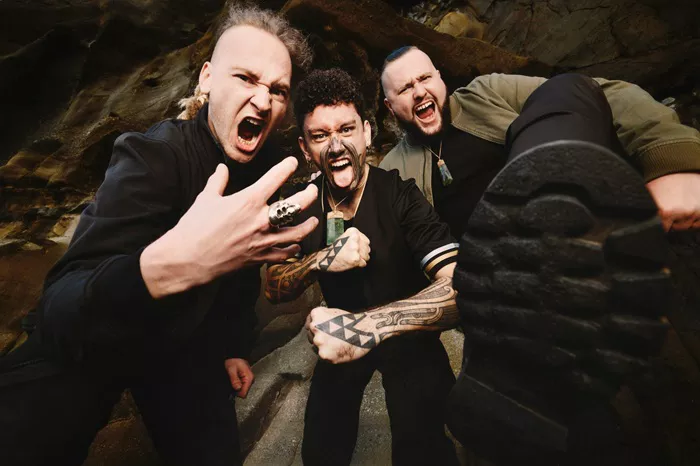Alien Weaponry, known for their explosive sound and powerful messages, continues to carve out a unique space in the music world with their new album Te Rā. Released last week via Napalm Records, the album touches on themes of cultural resilience, societal struggles, and environmental challenges, blending English and te reo Māori lyrics. As the band’s bassist, Tūranga Morgan-Edmonds is not only part of this cultural dialogue but also carries the deep symbolism of Māori tradition through his tattoos, specifically his Moko. In this Tattoo Talk interview, Morgan-Edmonds shares his personal tattoo journey and the cultural significance of Moko.
What was the first tattoo you ever got?
Tūranga Morgan-Edmonds: “The first Moko I received was the ‘Niho Taniwha’ design on my forearm. This pattern, made up of triangles, is inspired by traditional Māori weaving and represents the teeth of the Taniwha, a Māori guardian or monster.”
Do you have an art background or any professional tattooing training?
“Before joining Alien Weaponry, I considered becoming a Kaitā, a traditional Māori tattoo artist, as I’ve always had a passion for the art form. However, I never felt confident enough in my skills to mark someone else permanently, so I decided to cover myself in tattoos instead (laughs).”
When did you know you wanted to get tattooed?
“Moko has always been a significant part of Māori culture for me. From a young age, I knew that once I came of age, I wanted to go through the process of adorning my body with Moko. So, as soon as I turned 18, I began my journey, and it’s still ongoing!”
What’s the most painful tattoo you’ve ever received?
“A lot of people assume that getting my face tattooed must have been the most painful, but because of the ritual surrounding it, I was almost in a meditative state. My hands, though, were a different story—those hurt a lot, and I’m glad I don’t have to go through that again.”
Do you have a recent tattoo that’s become a personal favorite?
“My Moko Mataora (traditional men’s facial marking) will always be my favorite and the most significant piece I’ve received. The facial markings hold deep sacred significance within our culture, and I don’t think that will ever change as I continue to cover my body in Moko throughout my life.”
Who are some of your favorite tattoo artists?
“I want to shout out to the Kaitā who have worked on my Moko: Lance Ngata, Te Haunui Tuna, Tristan Marler, and Aaron Luckman. These artists are incredibly skilled in the traditional art of Moko.”
What’s the longest tattoo session you’ve ever had?
“My face took the longest, around eight hours. I bled a lot, so the artist had to go over the lines repeatedly because the blood was pushing the ink out. Sounds worse than it was (laughs). I also have a plan to get a ‘pūhoro’ style Moko, which covers both thighs, your lower back, and bum. That could take a minimum of five days to complete, depending on your size.”
Do any of your tattoos hold particularly special meanings?
“Yes, Moko represents much more than just a design. It’s a thousand-year-old tradition that’s deeply sacred to Māori people. Each Moko is uniquely designed for the individual and represents their lineage and achievements. No two Moko are the same.”
Do you have any new tattoos planned?
“My Moko Mataora currently only covers the lower part of my face, but once it’s completed, it will cover my entire face. The timing of that depends on the events and achievements in my life, so it could happen soon or take many years.”
Have any of your tattoos been especially painful?
“Not really due to the pain, but after getting my face tattooed, I looked in the mirror for the first time, and I completely broke down. The emotional weight of seeing myself with my markings, something that’s been part of me for my entire life, was overwhelming. My family was there with me, crying too.”
When do you typically get tattoo work done?
“For me, getting Moko is a deliberate process. I have a clear plan of what areas of my body I want covered. The designs are created on the day by the Kaitā, and I don’t know exactly what they’ll look like until they’re done. If you’re getting Moko for its appearance alone, you’re not understanding its deeper significance. Every symbol and line has a story.”
Do you feel people choose tattoo artists with the same thoughtfulness as they choose designs?
“In the case of Moko, it’s not just any tattoo artist who can perform the ritual. Kaitā are trained in the ancient traditions of Moko, often passed down through generations. The artist you choose is incredibly important, as they are not just marking your skin but carrying forward a sacred cultural practice. It’s about the connection between the recipient and the artist as much as the design itself.”
Tūranga Morgan-Edmonds’ relationship with Moko goes far beyond tattoos; it’s a profound connection to his cultural heritage. As Alien Weaponry continues to raise awareness through their music and their message, Morgan-Edmonds’ Moko serves as a permanent reminder of the strength and resilience embedded in his identity and his people.
Related topics:

